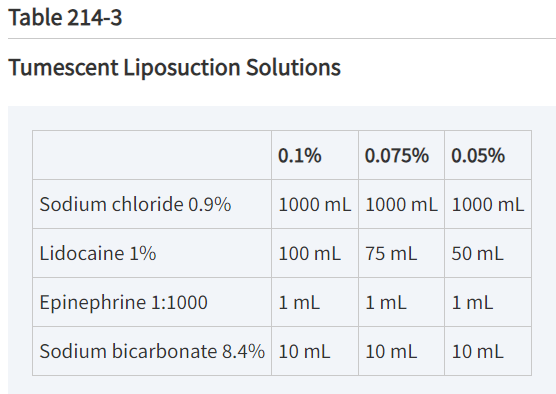Dermatology Question of the Week: Surgical Skills

Question: A 40-year-old female presents to your office for liposuction. She weighs approximately 80kg, has no other medical conditions, and is not on any medications. Presurgical blood work and the infectious screening is negative. You determine she is a good candidate for liposuction. You decide to use a standard Klein solution for tumescent anesthesia consisting of 0.1% lidocaine, 1:1,000,000 epinephrine, and normal saline. How much volume of this formulation can you safely give the patient?
Answers:
A. 560 mL
B. 1,120 mL
C. 4,400 mL
D. 8,800 mL
E. 2,240 mL
Rationale: Tumescent lidocaine is dilute local anesthesia infiltrated until the skin becomes firm and tense. It was developed by Dr. Klein, a dermatologist, for liposuction but can be utilized in a variety of procedures including venous ablation, large excisions, face lifts, and burns. The maximum safe dose reported is 55mg/kg of tumescent anesthesia when used for liposuction. When used for other indications, this limit is lowered to 28mg/kg as a large volume of the anesthetic present in the adipocytes is removed during liposuction but not in other procedures. It is important to be aware of the maximum safe doses of lidocaine and calculate appropriate max volume of tumescent anesthesia prior to surgical procedures to avoid lidocaine-associated systemic toxicity which can frequently present hours after infiltration given the slow absorption of tumescent anesthesia. Tumescent anesthesia has multiple benefits including prolonged anesthesia, avoiding general anesthesia, the ability to give a larger volume and thus anesthetize a larger area, and hemostasis. Different concentrations of tumescent lidocaine exist and some common formulations are shown in the following chart.

Correct answer: C
Given a weight of 80kg and a maximum limit of 55mg/kg, the max lidocaine dosage is 4,400mg. In this scenario, we were using 0.1% tumescent lidocaine. 0.1% contains 1mg per mL. Therefore, the patient can receive up to 4,400mL safely.
Incorrect answers:
A. 560mL is the limit if we are using 1% (10mg/mL) lidocaine with epinephrine (not tumescent) as the limit is 7mg/kg.
B. 1,160mL is the limit if we are using 0.5% (5mg/mL) lidocaine with epinephrine (not tumescent) as the limit is 7mg/kg.
D. 8,800mL would be the correct answer for tumescent anesthesia if we used 0.05% tumescent lidocaine as there is 0.5mg per mL.
E. 2,240mL would be the correct answer for tumescent anesthesia if it was being performed for a procedure that is not liposuction. The maximum safe dose is 28mg/kg or 2,240mg.

Create a Free MyAccess Profile
AccessMedicine Network is the place to keep up on new releases for the Access products, get short form didactic content, read up on practice impacting highlights, and watch video featuring authors of your favorite books in medicine. Create a MyAccess profile and follow our contributors to stay informed via email updates.